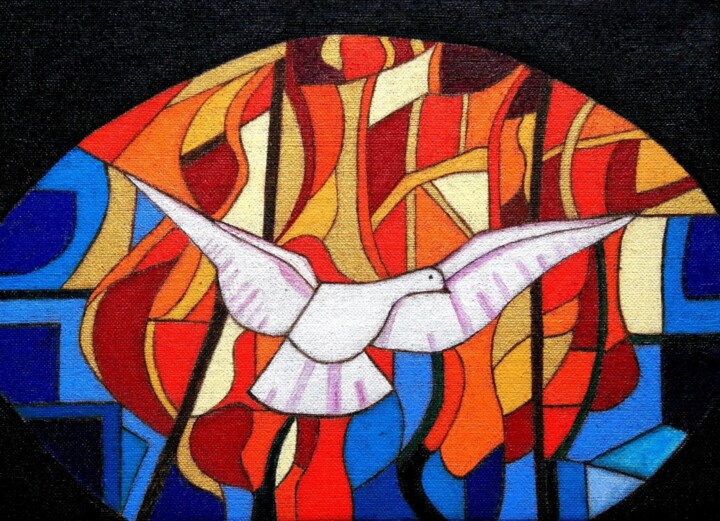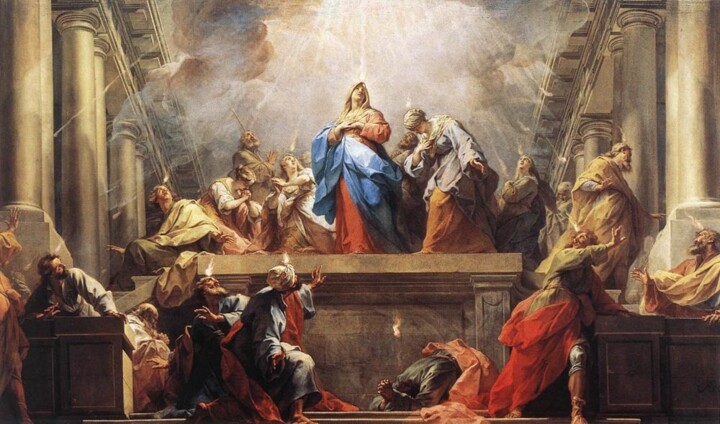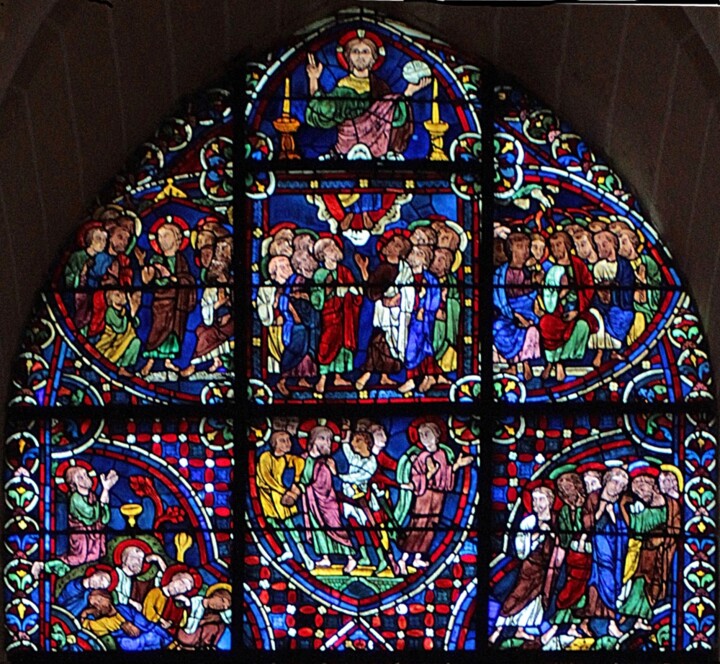Pentecost is an important holiday in Christianity that celebrates the descent of the Holy Spirit on the apostles and other followers of Jesus Christ, as described in the New Testament, in the book of Acts of the Apostles (Acts 2:1- 31). It is celebrated on the fiftieth day after Easter Sunday (hence the name "Pentecost", which means "fiftieth" in Greek) and marks the end of the Easter period.
The importance of Pentecost in Christianity is multiple:
Birth of the Church : Pentecost is often considered the birth of the Christian Church. With the descent of the Holy Spirit, the apostles were given power and guidance to begin their mission to preach the gospel to all nations, thus marking the beginning of the global expansion of Christianity.
Gift of the Holy Spirit : Pentecost celebrates the gift of the Holy Spirit to the disciples, an event that enabled early Christians to speak in tongues, heal the sick, and preach with boldness and conviction. For Christians, the Holy Spirit is the comforter promised by Jesus Christ, present to guide, strengthen and sanctify believers.
Unity and diversity : The event of Pentecost, where the apostles spoke in different tongues but were understood by people of different nations, is often seen as a symbol of the universality of the Church and its mission to bring together all nations under the banner of Christ, while respecting their cultural and linguistic diversity.
Common themes and symbols associated with Pentecost in art
In religious art, Pentecost is often represented in a very symbolic way. The most common elements include:
Tongues of Fire : Flames or tongues of fire resting on the heads of each apostle and Mary, the mother of Jesus, are one of the most recognizable symbols of Pentecost. These flames represent the presence of the Holy Spirit and the gift of tongues, enabling the apostles to speak in various tongues to preach the Gospel to all nations.
The Dove : The dove is another strong symbol of Pentecost, representing peace and purity, as well as the physical presence of the Holy Spirit. In many works of art, a dove is often seen descending from heaven towards the apostles.
The Apostles and Mary : The apostles and sometimes Mary are usually depicted together, often seated in a circle, to illustrate the event of Pentecost as described in the Acts of the Apostles. This provision emphasizes the unity of the early Christians and the importance of community.
Diversity of Peoples : Some works of art may include people from different nations to illustrate the gift of tongues and the universal mission of the Church, reflecting the ability of the apostles to speak to everyone in their own language.
The Church : Images or symbols of the Church, such as a building or a congregation of people, can be incorporated to symbolize the birth of the Church at Pentecost.
Wind and Breath : Although less visually obvious than the flames or the dove, the wind is a powerful symbol of Pentecost, representing the breath of life and the energy of the Holy Spirit. In some works this may be indicated by waving clothing or moving elements of nature.
- The Book or Scroll : These elements can symbolize the Scriptures or the new law brought by the Holy Spirit. They highlight the role of teaching and preaching in the mission of the apostles.
- Light : Light is often used to symbolize divine presence and revelation. The way light is depicted in Pentecostal artwork can vary, but it generally serves to highlight holy figures and represent spiritual illumination brought by the Holy Spirit.
 Laure Barlet, THE HOLY SPIRIT OF PENTECOST (2023)
Laure Barlet, THE HOLY SPIRIT OF PENTECOST (2023)
Historical and Biblical Context
Historical and biblical origins : Before becoming a Christian holiday, Pentecost was a Jewish holiday known as Shavuot, celebrated fifty days after Passover. Shavuot originally marked the end of the grain harvest period and later became associated with the commemoration of the giving of the Torah to Moses on Mount Sinai.
In the Christian context, Pentecost is described in most detail in the Acts of the Apostles (Acts 2:1-31). According to the account, after Jesus' ascension, his disciples and a few others, including Mary, Jesus' mother, and his brothers, gathered in a house in Jerusalem to celebrate the Jewish festival of Pentecost. While they were together, a sound like that of a strong wind filled the house, and tongues like flame appeared and rested on each of them. Filled with the Holy Spirit, they began to speak in other tongues, as the Spirit granted them utterance.
This event is considered the birth of the Christian Church. The disciples, now filled with the Holy Spirit, were equipped to undertake the mission Jesus had given them: to preach the gospel to all nations. The account goes on to describe how Peter addressed the gathered crowd, explaining the event as the fulfillment of prophecies and preaching the resurrection of Jesus. On that day, approximately three thousand people were baptized and added to the community of believers.
Theological Significance and Celebration : Pentecost is considered a pivotal moment in Christian history – the moment when the Holy Spirit was given to the disciples, enabling them to begin their public ministry. It also symbolizes the universality of the Church, as the gift of tongues allowed the disciples to communicate with people of different nations and cultures.
Traditionally, Pentecost is celebrated with Bible readings, songs, prayers and sermons that focus on the theme of the Holy Spirit. In many churches, red, symbolizing fire and the Holy Spirit, is used in decoration and liturgical vestments to reflect the fire imagery of Pentecost. The feast is an opportunity for Christians to reflect on the role of the Holy Spirit in their lives and in the Church.
The religious art of Pentecost
Pentecost has been a popular subject in Christian art over the centuries, illustrated in various ways depending on the era, artistic style and cultural context.
Byzantine and medieval art : In Byzantine art and early medieval works, Pentecost is often depicted as a scene in which the Apostles sit in a circle or semi-circle, sometimes around the Virgin Mary. Above them, rays or tongues of fire descend from the sky, symbolizing the Holy Spirit. These works emphasize the divine nature of the event and the community of believers.
Renaissance : With the revival of interest in classical antiquity during the Renaissance, depictions of Pentecost became more dynamic and humanized. Artists like Titian and Giotto depicted the Apostles with emotional expressions and dramatic gestures, capturing the moment of their divine inspiration. The Virgin Mary is often center stage, adding a maternal dimension to the event.
Baroque : In Baroque art, depictions of Pentecost become even more theatrical and expressive, with strong contrast of light and shadow and dynamic compositions. Artists like Rubens and El Greco illustrated the scene with a great sense of movement and emotion, reflecting the spiritual intensity of the event.
Modern and Contemporary Periods : Beginning in the 19th century and continuing in contemporary art, depictions of Pentecost can vary widely, reflecting the varied artistic styles and concerns of their times. Some artists may choose to approach the theme abstractly, focusing on symbols or colors to evoke the experience of the Holy Spirit. Others may incorporate contemporary cultural or social elements to make the scene more relevant to modern audiences.
Colors used
Red : Red is often used to represent the fire of the Holy Spirit and symbolizes divine love, passion and sacrifice. In Pentecost scenes, red can be particularly pronounced to illustrate the power and warmth of the moment.
Gold and Yellow : These colors are often associated with divinity, holiness and divine light. They can be used to accentuate tongues of fire or to illuminate the entire scene, suggesting the presence of God.
Blue : Blue is frequently used for the Virgin Mary and symbolizes tranquility, fidelity and grace. Its presence in the scenes of Pentecost can underline its central role and its purity.
Iconic works of art
Here are some specific examples of artwork depicting Pentecost, each offering a unique perspective on this biblical event through different mediums and artistic styles:
1. Pentecost by El Greco (1600)

Pentecost, El Greco (around 1600), 275 x 127 cm, Prado Museum, Madrid (Spain)
Background : This work was created by El Greco, a late Renaissance artist known for his distinctive style that blends Byzantine elements with Western Mannerism. Created towards the end of his life, this painting reflects his deep spirituality and his unique approach to color and form.
Technique : Oil on canvas. El Greco is famous for his elongated figures, vibrant colors and dramatic use of light and shadow, which add a mystical dimension to his religious subjects.
Symbolism : In this work, El Greco depicts the Apostles surrounding the Virgin Mary, all looking up to heaven or in a state of intense spiritual reception. Tongues of fire are depicted as tiny flames above their heads. Divine light coming from the top of the canvas illuminates the figures, symbolizing the presence of the Holy Spirit. The colors used, including red, blue and gold, reinforce the theme of divinity and spiritual transformation.
2. Pentecost by Jean II Restout (1732)

Jean II Restout: Pentecost (1732)
Context : This painting was created by Jean II Restout, an 18th century French painter, for the Abbey of Saint-Denis in France. The work reflects the characteristics of the Rococo style while maintaining a deeply religious subject matter.
Technique : Oil on canvas. Restout uses a dynamic composition, with figures arranged in a circle around the central light, representing the Holy Spirit. The technique shows a mixture of realism in the figures and abstraction in the representation of the sky and divine light.
Symbolism : The light coming down from above symbolizes the Holy Spirit, illuminating the Apostles and the Virgin Mary at its center. The expressions of the Apostles vary from wonder to deep contemplation, illustrating various reactions to the divine event. The tongues of fire are discreet but present, and the color palette emphasizes tones of red and gold, emphasizing passion and holiness.
3. Pentecost stained glass windows, Chartres Cathedral (12th-13th century)
 Stained glass window of the Apostles, details, Chartres Cathedral (France), Pentecost, the Apostles receive the Spirit in the form of tongues of fire (top right)
Stained glass window of the Apostles, details, Chartres Cathedral (France), Pentecost, the Apostles receive the Spirit in the form of tongues of fire (top right)
Context : The stained glass windows of Chartres Cathedral in France are among the most famous in the world, illustrating various biblical scenes with remarkable artistic mastery. The Pentecost stained glass window is part of this exceptional heritage.
Technique : Stained glass. This technique involves assembling pieces of colored glass held together by strips of lead. Natural light passing through the glass brings the depicted scenes to life.
Symbolism : The stained glass window shows the Apostles and the Virgin Mary with tongues of fire above their heads. The arrangement of the figures and the use of natural light passing through the stained glass window reinforce the impression of a sacred and divine moment. The rich and varied colors of the glass emphasize different aspects of the scene, with a predominance of blue and red symbolizing the divine and passion respectively.
How does Pentecostal art reflect and influence theology and religious practice?
Pentecostal art, like other forms of religious art, serves as both a reflection and influence on theology and religious practice. Here are some ways Pentecost-related art interacts with these aspects:
Theological reflection:
Illustration of the Doctrine : Artistic representations of Pentecost make complex doctrines visible and understandable. For example, the descent of the Holy Spirit in the form of tongues of fire helps believers conceptualize abstract ideas such as the presence of God and divine inspiration. Art makes theology tangible and accessible.
Expression of Mysticism : Pentecostal art can also express the mystical dimension of the Christian faith, illustrating the personal and transcendent experience of the presence of God. This encourages a more intimate and experiential approach to religion, beyond simple ritual observance.
Influence on religious practice:
Meditation and Devotion : The art of Pentecost offers the faithful a point of focus for meditation and prayer. By contemplating a painting or stained glass window depicting Pentecost, believers can immerse themselves in the story and draw inspiration for their own spiritual lives. This can strengthen devotion and encourage deeper reflection on the role of the Holy Spirit.
Education and Catechesis : Historically, religious art has often been used to teach the principles of faith to the faithful, many of whom cannot read. Depictions of Pentecost can serve as educational tools, visually explaining the events and teachings of the Bible. This helps believers of all ages understand and internalize fundamental aspects of their faith.
Community and Identity : Art related to Pentecost can also strengthen the sense of community belonging. By celebrating this founding event of the Church, art helps remind the faithful of their common heritage and their shared mission, inspired by the Holy Spirit. This can encourage unity and collective action within the community.
Celebration and Liturgy : Finally, the art of Pentecost enriches the liturgy and religious celebrations. Pentecost-specific artwork can be integrated into worship spaces and liturgical practices, helping to mark and honor this special day in the Christian calendar. Art helps create an environment that promotes spiritual reflection and celebration.
The art of Pentecost in different Christian traditions
The art of Pentecost varies greatly between different Christian traditions, reflecting each tradition's specific theological beliefs, liturgical practices, and cultural contexts.
Catholic tradition:
In Catholic art, Pentecost is often represented with great solemnity and detail, highlighting the descent of the Holy Spirit in the form of tongues of fire on the apostles and the Virgin Mary, generally gathered in the upper room (Cenacle). . The works can be found in a variety of forms such as paintings, frescoes, stained glass and mosaics. Bright colors, especially red symbolizing the fire of the Holy Spirit, are frequently used. This tradition emphasizes the presence of Mary and the unity of the apostles, emphasizing the birth of the Church and the universal mission to preach the Gospel.
Orthodox tradition:
In Orthodox art, Pentecost is also known as the Feast of the Holy Trinity. Pentecost icons in the Orthodox tradition often feature formal symmetry, with the apostles arranged in a semicircle or in two symmetrical rows, sometimes with the Virgin Mary in the center. A special feature of the Orthodox Pentecost icon is the mysterious figure at the bottom of the icon, representing the world or sometimes called "Cosmos", symbolizing the peoples not yet evangelized. The icons underline the cosmic dimension of the event, highlighting the role of the Church in the redemption of the entire cosmos.
Protestant traditions:
In Protestant traditions, art related to Pentecost may be less prevalent due to a historical trend toward a more restrained aesthetic in worship. However, when Pentecost is depicted, it often focuses on conveying the message of the Gospel and the emancipatory aspect of the Holy Spirit. Works of art, such as paintings or stained glass windows, may focus more on the didactic aspect, highlighting the apostles preaching or being inspired to speak in tongues. The colors and symbols remain similar, with a particular emphasis on light and fire as representations of the Holy Spirit.
Pentecostal and charismatic traditions:
Although these traditions are not known for a specific artistic style related to Pentecost, their theology places a strong emphasis on the personal, present-day experience of the Holy Spirit. The art found in these communities may be more contemporary and diverse, reflecting personal experiences of the Holy Spirit. Artistic representations can be less formal and more experimental, highlighting themes such as healing, prophecy and personal transformation.


 Jean Dubreil
Jean Dubreil